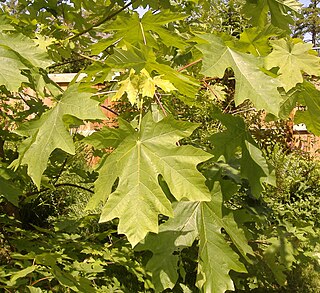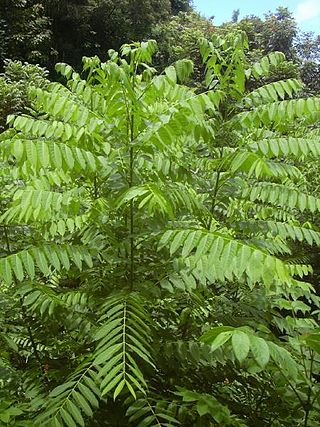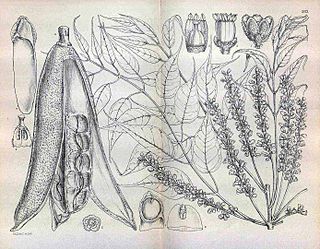
Plywood is a composite material manufactured from thin layers, or "plies", of wood veneer that are glued together with adjacent layers, having their wood grain rotated up to 90° to one another. It is an engineered wood from the family of manufactured boards, which include medium-density fibreboard (MDF), oriented strand board (OSB), and particle board.

Liriodendron is a genus of two species of characteristically large trees, deciduous over most of their populations, in the magnolia family (Magnoliaceae).

Acer macrophyllum, the bigleaf maple or Oregon maple, is a large deciduous tree in the genus Acer.

Aucoumea klaineana is a tree in the family Burseraceae, native to equatorial west Africa in Gabon, the Republic of the Congo, and Río Muni. It is a large hardwood tree growing to 30–40 m tall, rarely larger, with a trunk 1.0–2.5 m diameter above the often large basal buttresses. The tree generally grows in small stands, with the roots of the trees intertwined with neighboring trees. In Gabon, it is the primary timber species.

Piper excelsum of the pepper family (Piperaceae) and commonly known as kawakawa, is a small tree of which the subspecies P. excelsum subsp. excelsum is endemic to New Zealand; the subspecies P. e. subsp. psittacorum is found on Lord Howe Island, Norfolk Island and the Kermadec Islands.

Entandrophragma cylindricum is a tree of the genus Entandrophragma of the family Meliaceae. It is commonly known as sapele or sapelli or sapele mahogany, as well as aboudikro, assi, and muyovu.

Entandrophragma is a genus of eleven known species of deciduous trees in the family Meliaceae.
The Viphya Mountains, also known as the Viphya Plateau or Viphya Highlands, are a mountain range in Malawi's Northern Region.

Cedrela odorata, commonly known as Spanish cedar, Cuban cedar, or cedro in Spanish, is a commercially important species of tree in the chinaberry family, Meliaceae native to the Neotropics.
The Kibira National Park is a national park in northwestern Burundi. Overlapping four provinces and covering 400 km2 (150 sq mi), Kibira National Park lies atop the mountains of the Congo-Nile Divide. It extends north from the provincial town of Muramvya to the border of Rwanda where it is contiguous with the Nyungwe National Park.
Altitudinal zonation in mountainous regions describes the natural layering of ecosystems that occurs at distinct elevations due to varying environmental conditions. Temperature, humidity, soil composition, and solar radiation are important factors in determining altitudinal zones, which consequently support different vegetation and animal species. Altitudinal zonation was first hypothesized by geographer Alexander von Humboldt who noticed that temperature drops with increasing elevation. Zonation also occurs in intertidal and marine environments, as well as on shorelines and in wetlands. Scientist C. Hart Merriam observed that changes in vegetation and animals in altitudinal zones map onto changes expected with increased latitude in his concept of life zones. Today, altitudinal zonation represents a core concept in mountain research.

The East African montane forests is a montane tropical moist forest ecoregion of eastern Africa. The ecoregion comprises several separate areas above 2000 meters in the mountains of South Sudan, Uganda, Kenya, and Tanzania.

Entandrophragma caudatum, or mountain mahogany, is a large Southern African tree belonging to the mahogany family and found in eastern and north eastern South Africa, Eswatini, Botswana, Angola, the Caprivi Strip region of Namibia, Zimbabwe, Zambia and Malawi. Kew currently recognises 12 other species of Entandrophragma, all with a tropical and sub-tropical African distribution.

Petersianthus quadrialatus is an emergent tropical rainforest tree species in the Lecythidaceae family. In the Visayas region called kapullan, in the Samar and Leyte areas - magtalisai. It is an indigenous tree species in the southeastern Philippines and one of the largest tree species in the Philippines islands.

Lannea welwitschii is a species of tree in the family Anacardiaceae. It is native to the tropical rainforests of West and Central Africa. The timber is used to make furniture and utensils and for many other purposes, the fruits can be eaten, and the bark is used to produce a dye, for making rope and in traditional medicine.
The Misuku Hills are a mountain range in Malawi's Northern Region.

The Victoria Basin forest–grassland mosaic is an ecoregion that lies mostly in Uganda and extends into neighboring countries. The ecoregion is centered north and west of Lake Victoria, with an outlier on the border of Ethiopia and South Sudan.













